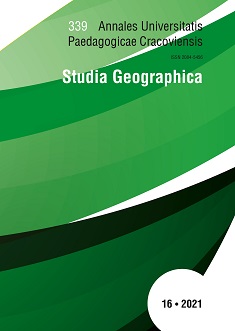Knowledge of organic architecture and its application in the hotel industry in the opinion of respondents
DOI:
https://doi.org/10.24917/20845456.16.2Abstract
Since the beginning of the history of construction and formation of primitive cultures, regardless of the place of residence and mode of existence, man has been observing nature. His interests were turned to the forms of structures of the plant world, the subsequent stages of their biological development, the ways in which they function, and consequently the possibility of using them in construction. Organic architecture emerged as a branch of modernist movement and is the form of architecture which in its idea refers to the tradition of places, spaces, landscape physiognomy and climate, as well as native forms of culture and art. Organic architecture uses innovative solutions that adapt power and renewable energy sources to shape a healthy and friendly living environment, according to the principles of modern holism.
The main objective of the article was to conduct a study in the form of a diagnostic survey on the respondents’ familiarity with the concept of sustainable development, ecohotel, and organic architecture and its application in hospitality. A total of 236 people took part in the survey, and based on their responses it can be concluded that the concept of sustainable development is known to 46.5% of all respondents, while more than half of the respondents
(52%) do not know and cannot characterize what organic architecture is. Also, half of the respondents taking part in the survey (50%) are not able to name any building falling in the style of organic architecture, and only 17% of all respondents are able to name a building falling in the style of organic architecture. Also, for most respondents (55%), the term ecohotel is unknown, and only 11% of the respondents were able to name an example of such a hotel.
References
Bohdanowicz, P. (2005). Turystyka a świadomość ekologiczna. Toruń: Wydawnictwo Adam Marszałek.
Dąbrowska-Milewska, G. (2010). Dom prywatny jako architektura oparta na ideach, Czasopismo Techniczne. Biblioteka Cyfrowa Politechniki Krakowskiej, 54-63.
Ewald, K. (2001). The neglect of aesthetics landscape planning in Switzerland. Land-scape and Urban Planning, 54, 255-266.
Hanks, D.A., Wright, F.L., Gallery, R. (1999). The Decorative Designs of Frank Lloyd Wright. Courier Corporation.
Hildebrand, G. (1991). The Wright space: pattern and meaning in Frank Lloyd Wright’s houses. Seattle: University of Washington Press.
Houdré, H. (2008). Sustainable Hospitality: Sustainable Development in the Hotel Industry. Cornell Industry Perspectives, No. 2.
Jagiełło-Kowalczyk, M. (2013). Organiczna forma przyszłości. Środowisko Mieszkaniowe, 180-184.
Kasprzak, K. (2006). Ochrona środowiska w hotelach; wybór problemów. Zeszyty Naukowe, Polskie Towarzystwo Gleboznawcze, z. 6.
Klein, L. (2007). Natura architektury - o inspiracjach organicznych we współczesnej architekturze. Sztuka i Filozofia, 30, 144-150.
Kowalczyk, A. (2001). Geografia hotelarstwa. Łódź: Wydawnictwo Uniwersytetu Łódzkiego.
Leśniak, J. (2012). Ekohotel SPA jako element zrównoważonej turystyki w Szwecji. Journal of Managament and Finance, 4(1), 419-433.
Moździerz, M. (2020). Od odzyskania przez Polskę niepodległości do modernizmu lat 60. XX w. Przestrzeń/Urbanistyka/Architektura, 1, 107-122.
Myga-Piątek, U. (2011). Koncepcja zrównoważonego rozwoju w turystyce. Problemy Ekorozwoju-Problems of Sustainable Development, 6(1), 145-154.
Nawrocka, E. (2010). Rozwój turystyki i rozwój zrównoważony, Gospodarka a środowisko, Prace Naukowe Uniwersytetu Ekonomicznego we Wrocławiu, 140, 87-100.
Paprzyca, K. (2018). Natura-Architektura-Człowiek. Środowisko Mieszkaniowe, 22, 140-146.
Pawlicz, A., Sidorkiewicz, M. (2013). Ekologia jako podstawa innowacyjnego produktu hotelarskiego. Innowacje w zarządzaniu, 195-207.
Pearson, D. (2001). New organic architecture: the breaking wave. California: University of California Press.
Poskrobko, B. (1998). Zarządzanie środowiskiem. Warszawa: PWE.
Redclift, M. (2009). The environment and carbon dependence: Landscapes of sustainability and materiality. Current Sociology, 57(3), 369-388.
Solska, M. (2011). Architektura organiczna i bioniczna a nowoczesne technologie budowlane. Czasopismo Techniczne. Architektura, 108(2-A/2), 187-196.
Szuba, B. (2012). Systemy środowiskowe a lokalne otoczenie człowieka. Opole: Politechnika Opolska, Studia i Monografia.
Świstak, E., Świątkowska, M., Stangierska, D. (2016). Strategia zrównoważonego rozwoju w hotelarstwie na przykładzie grupy Accor. Handel Wewnętrzny, 1(360), 133-142.
Worłowska, M., Marko-Worłowska, M. (2011). Problemy ekologiczne w zielonej architekturze miasta. Proceedings of ECOpole, 5(1), 343-347.
Wright, F.L., Hitchcock, H.R. (1970). Frank Lloyd Wright. Thames and Hudson.
Zaręba D. (2010). Ekoturystyka. Warszawa: PWN.
Downloads
Published
Issue
Section
License
The submission of a paper to be published is synonymous with an agreement to transfer the copyright free of charge from the author to the publisher. The author also agrees to permit the publisher to publish the paper in printed form, open access online form, digital library form and other digital platforms with which the publisher has or will have a publishing agreement. Furthermore, the author agrees to not limit the number of copies that may be printed or issued by the publisher. In the case of co-authored papers, it is assumed that the corresponding author is authorized to represent the remaining co-authors in this respect. Authors are requested to sign a copyright declaration.

